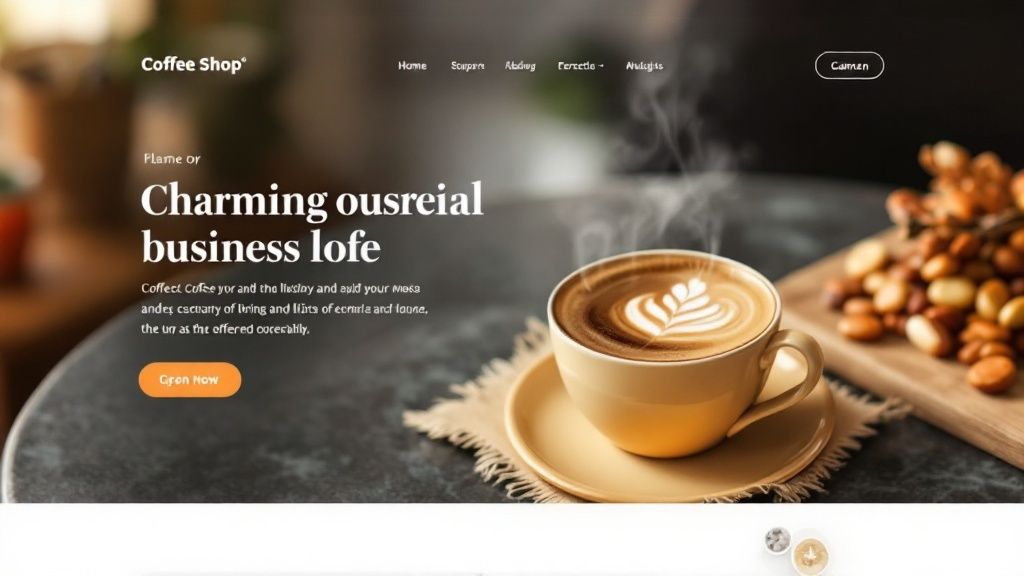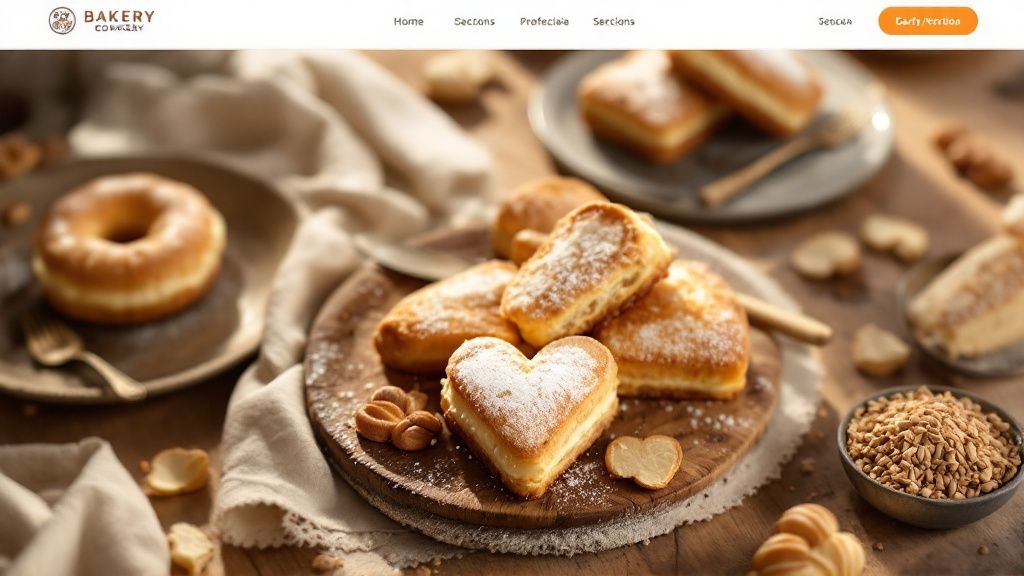15 Outstanding Small Business Website Examples: Learn From Industry Leaders
The Strategic Value of Modern Business Websites
Every business needs to have a strong digital presence to succeed. Your website is now your 24/7 storefront and the first point of contact for most potential customers. A professionally designed website can set your business apart from competitors and create meaningful connections with your target audience.
Why a Website Is More Than Just an Online Brochure
Today’s business websites serve multiple essential functions, including customer acquisition, brand building, and revenue generation. They help companies reach new audiences, tell their story effectively, and provide easy ways for customers to engage and buy. For example, a local bakery can use their website to display daily specials, take online orders, and offer virtual baking classes - expanding their reach beyond their physical location.
A professional website also helps build trust and credibility with potential customers. People often research businesses online before making purchase decisions, checking reviews, services offered, and contact information. A well-maintained website with customer testimonials and clear business details shows legitimacy and helps customers feel confident in choosing your business.
The Growing Importance of Online Presence for Small Businesses
Recent data shows that small businesses are prioritizing their online presence more than ever. As of 2023, 73% of U.S. small businesses have a website, and another 23.5% plan to create one soon. Learn more about small business website statistics here. These numbers clearly show that business owners understand having a website is crucial for attracting and keeping customers in today’s market.
Leveraging Small Business Website Examples for Inspiration and Success
Looking at successful small business websites can provide valuable insights for improving your own online presence. By studying different approaches to design, navigation, and content, you can identify what works well and what doesn’t. However, don’t just copy another site - analyze why certain elements are effective and adapt those ideas to fit your unique business goals and target customers.
Building Blocks of High-Converting Business Websites

A small business website needs to do more than just exist online. Its real purpose is to create an inviting digital space that turns visitors into customers. This means carefully selecting and implementing key elements that encourage people to take action - whether that’s making a purchase, scheduling an appointment, or joining an email list.
Navigation and Visual Hierarchy: Guiding the Customer Journey
Your website’s navigation serves as a map for visitors. Clear menus and intuitive organization help people quickly find what they’re looking for, which keeps them engaged with your site. Good navigation includes logical dropdown menus, breadcrumb trails showing page location, and prominent calls-to-action. The visual layout matters too - using contrasting colors, different text sizes, and strategic white space helps direct attention to important content.
Trust Signals and Engagement Features: Building Credibility
Small businesses need to establish trust quickly. Including proof elements like customer reviews, security badges, and satisfaction guarantees helps visitors feel confident in your business. Showing accepted payment methods also provides reassurance. Interactive elements like chat support, contact forms, and social media connections create valuable two-way communication. These features help you better understand and serve your customers’ needs.
Mobile Optimization and User Experience: Reaching Everyone, Everywhere
Mobile-friendly design is essential for modern websites. Your site needs to work smoothly on all devices - phones, tablets, and computers. Site speed and ease of use directly impact success. Design plays a major role in first impressions, with studies showing that 94% of people judge websites initially on visual design elements like images, colors and typography. See more website statistics here. When visitors have a good experience, they stay longer and explore more pages.
Balancing Aesthetics With Functionality: The Key to Conversion
While an attractive website is important, it must also be practical and easy to use. The most effective sites combine appealing visuals with functional elements that help visitors complete their goals. This includes prominent call-to-action buttons, simple forms, and straightforward checkout processes for online stores. Focus on these core building blocks to create a website that both looks good and delivers results for your small business.
Service Business Success Stories: 5 Website Deep Dives

Creating an effective small business website takes more than just good looks. You need a smart plan to showcase your services and turn website visitors into paying clients. Let’s look at 5 real examples of service businesses that have created excellent websites.
Building Trust Through Personal Connection
The best service websites focus on building real connections with potential clients. Take Acupuncture with Fabi - she includes her photo and personal story right on the homepage. This helps visitors feel like they know her before booking an appointment. Similarly, freelance photographer Holyziner uses their actual handwritten signature as a logo, adding an authentic personal touch to their brand.
Making It Easy for Clients
A smooth, simple website experience helps turn visitors into customers. Islango, a yacht rental company, uses beautiful photos of their boats and destinations to catch attention. They also let customers book directly through their website with no hassle. Another good example is Bonny, a creative agency that uses clear navigation to help visitors easily find what they need.
Showing Value in Creative Ways
Service businesses must clearly show why they’re worth hiring. Puffin Packaging, which makes eco-friendly packaging, does this in a fun way - they share reviews from their “clients” (their pets!). This playful approach fits their brand while highlighting their commitment to sustainability. Milestone, a construction company, takes a different route by using clean design and a photo gallery of completed projects to demonstrate their skills.
Creating Helpful Content
Smart service businesses use content to establish expertise. Bonny’s “Bonny Journal” blog shares useful industry insights that help potential clients while showcasing the agency’s knowledge. This approach helps them become a trusted source of information in their field.
Key Takeaways for Your Business
These examples show what works for service business websites: building trust through personal connection, making things easy for clients, showing clear value, and sharing helpful content. By using these proven strategies and adapting them for your business, you can create a website that brings in more clients.
E-commerce Excellence: 5 Small Business Website Breakthroughs
Making sales online requires more than just showing products - it needs excellent design, simple navigation, and smart marketing strategies. Here are 5 small business websites that show how it’s done right.
Mastering Product Storytelling
Great e-commerce sites create emotional connections through storytelling. Take Ducknology, a jewelry brand that stands out with playful emojis and unique fonts that reflect their personality. Their product descriptions read like mini-stories, making each piece feel special. This storytelling approach turns simple browsing into an engaging experience that keeps customers clicking.
Streamlining the Checkout Process
When checking out gets complicated, sales drop. Objective gets this right with their clean, simple checkout flow. They offer multiple secure payment options and keep forms short and sweet. Their focus on making purchasing easy has led to 20% higher sales completion rates.
Building Customer Loyalty
Keeping customers coming back is crucial for long-term success. Ubio Labs excels at this through:
- Clean, modern website design
- Active social media integration
- Engaging loyalty programs
- Exclusive member offers
This community-focused approach keeps their customers returning regularly.
Immersive Product Experiences
Piboco’s children’s reading app shows how to create an engaging online presence. Their homepage uses large text and fun shapes to instantly communicate their focus on learning and entertainment. Clear calls-to-action make it simple for visitors to try the app.
Mobile-First Approach
With over 60% of online shopping now happening on phones, mobile optimization is essential. Puffin Packaging delivers a seamless experience across all devices with:
- Responsive design that adapts to screen size
- Fast loading speeds
- Easy-to-tap buttons
- Readable text at any size
These examples show how thoughtful design and strategic execution drive e-commerce success. By focusing on user experience, compelling storytelling, and building customer relationships, these businesses have built strong online presences that convert visitors into loyal customers.
Local Business Innovation: 5 Websites That Drive Foot Traffic

Small businesses need effective ways to connect their online presence with in-store visits. Let’s look at five small business website examples that successfully bring online visitors through their physical doors by becoming key parts of their local communities.
1. Highlighting Local SEO
When people search for nearby services, showing up in local search results is crucial. Take ‘Hales’ flower shop - they use local SEO techniques to make sure their “Fresh flowers for any budget” tagline appears when customers look for florists in their area. This smart approach brings more foot traffic to their storefront.
2. Integrating Online Ordering with In-Store Pickup
Making it easy to order online and pick up in person creates a smooth customer experience. Many restaurants and cafes find that offering online ordering with in-store pickup not only boosts sales but also brings customers into their physical location, where they often make extra purchases.
3. Leveraging Local Events and Promotions
The best business websites serve as information hubs for local happenings. By sharing details about community events and special offers, they build a sense of community that gets local customers involved both online and in person. Whether it’s exclusive in-store events or special deals tied to local festivals, this approach makes websites central to community life.
4. Building Community Through Digital Channels
Strong online connections lead to loyal local customers. A neighborhood bookstore might use their website to organize book clubs, host virtual author talks, or share personalized reading suggestions. This community-building creates a devoted customer base that regularly visits both their website and physical store.
5. Enhancing Customer Experience
Great service matters just as much online as it does in person. When businesses create websites that match their in-store service quality, they extend their hospitality to the digital world. For example, a coffee shop might post brewing guides or virtual barista tips that inspire coffee lovers to visit and buy specialty beans or equipment.
These examples show how thoughtful web design with a local focus can turn small business websites into bridges that bring online visitors into physical stores. By blending their digital presence with community involvement, local businesses can succeed both online and offline. Learn more about improving your small business website at GWC.
Your Website Implementation Blueprint: From Strategy to Launch

Building an effective website requires careful planning and execution. This guide breaks down the key phases to help you create a small business website that delivers real results.
Phase 1: Defining Your Digital Strategy
Start by setting clear direction for your website project. Define your target audience, determine the main purpose of your site, and establish specific goals you want to achieve. This could be generating leads, driving sales, or building awareness. Having this clarity will guide all your decisions moving forward.
Phase 2: Choosing the Right Platform
Pick a platform that fits your needs and skills. Consider factors like ease of use, room for growth, SEO capabilities, and costs. Popular options include WordPress for flexibility, or simpler builders like Wix and Squarespace for beginners.
Phase 3: Content Creation and Optimization
Strong content helps you connect with visitors and rank well in search results. Write clear, engaging copy for your pages, create helpful blog posts, and add photos and graphics that support your message. Looking at other small business website examples can spark ideas for your own content.
Phase 4: Design and Development
Focus on creating a clean, professional design that’s easy to navigate. Make sure your site works smoothly on all devices with mobile-responsive design. Keep the layout simple and intuitive so visitors can quickly find what they need.
Phase 5: Pre-Launch Checklist and Testing
Test everything thoroughly before going live. Check all links, forms, and shopping functions. Make sure your site loads quickly and has proper security in place. First impressions matter, so catch any issues before launch.
Phase 6: Launch and Post-Launch Optimization
Monitor your site’s performance after launch using analytics. Track important metrics like visitor numbers, bounce rates, and conversions. Use this data to make ongoing improvements and keep your site fresh and effective.
Want expert help building your website? Visit GWC to learn how we can create a website that helps your small business grow.